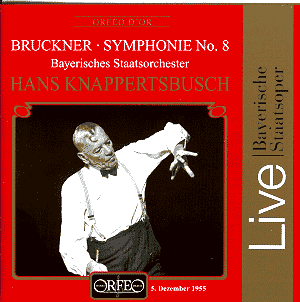Over the years I’ve read reviews of several recordings by Hans
Knappertsbusch which have included statements to the effect that he was
not at his best in the recording studio and that the results he achieved
‘live’ were much more inspirational, less inhibited. This Orfeo issue
offers an opportunity to assess him in the concert hall and, frankly,
the results are a major disappointment.
To be candid, this was a performance which wearied
me. My listening notes are peppered with comments such as "impetuous"
and "headstrong". The first movement sounded urgent at first
but I soon came to feel that everything was rushed. There was no sense
of the music being given time to breathe. The first great climax, for
example, (track 1, 6’35") seems to be snatched at and it lacks
any breadth. Even the poignant coda (11’30"), one of the most moving
passages in all Bruckner, is prosaic. It should sound utterly spent
and bereft but here it is just matter of fact.
The scherzo too is brusque and commonplace. The trio,
marked langsam, has no real sense of relaxation. It was at this
point that out of curiosity I looked at the other recordings of this
work which I have in my library. Compared with the other eight versions
on my shelves ‘Kna’ is by some distance the swiftest. For example, he
takes a mere 12’31" for the first movement. The other interpretations
range from 14’34" (Barbirolli) to 18’15" (Goodall). For the
work as a whole, the closest that anyone else comes to Knappertsbusch’s
overall timing of just over 70 minutes is Barbirolli at 73’45".
Most other readings, whether ‘live’ or studio made, clock in at over
80 minutes. It will be noted that ‘Kna’ uses an unfamiliar edition but
lest it be thought that textual cuts explain the brevity of this performance,
this is not the case. The 1892 edition, the notes claim, does not vary
too greatly from Leopold Nowak’s edition. The differences are "relatively
marginal and primarily apply to retouches in instrumentation."
Having followed this performance with a Nowak score I can confirm that
this appears to be true. No, I fear that the only reason that Knappertsbusch
is so much quicker than other conductors is that he rushes the symphony
off its feet.
The great adagio starts off well enough but at letter
A in the score (track 3, 1’01") when the brass enter the upward
arpeggios are pressed forward unduly. Sad to say, the performance of
the movement as a whole is no better than adequate and the sublime coda
sounds perfunctory. The massive finale is no better than what has gone
before. Between cues N and O in the score there is a brass-dominated
tutti passage for full orchestra, underpinned by a timpani ostinato.
This is one of the most grotesque passages in the whole performance.
Knappertsbusch takes the dynamic down to piano and then increases
both the volume and the tempo over the succeeding bars. The effect is
vulgar and completely unauthorized (at least according to the Nowak
score). I found little to cheer me in the remainder of the movement
and the final peroration sounds portentous and vulgar with a huge, unmarked
rallentando in the closing bars.
The adulatory booklet notes describe this and other
contemporary Bruckner performances by the same conductor as having "spontaneity,
freshness and [a] sense of rightness." Well, I’m sorry but I completely
disagree. To my ears this performance sounds superficial and unauthentic.
Nor does the quality of the playing help. The booklet quotes a contemporary
review of the concert which avers that "all the sections of the
Bavarian State Orchestra played excellently." I’m afraid I found
the playing scrappy and untidy.
I’m sorry to be so negative but I found nothing in
this performance to recommend it. Indeed, I feel that this issue ill
serves the reputation of this conductor. Admirers of Knappertsbusch
may be attracted to this release but Brucknerians should look elsewhere.
Not recommended, I’m afraid.
John Quinn


